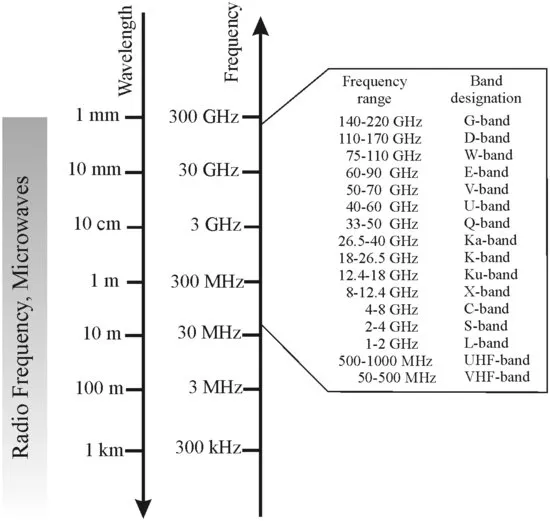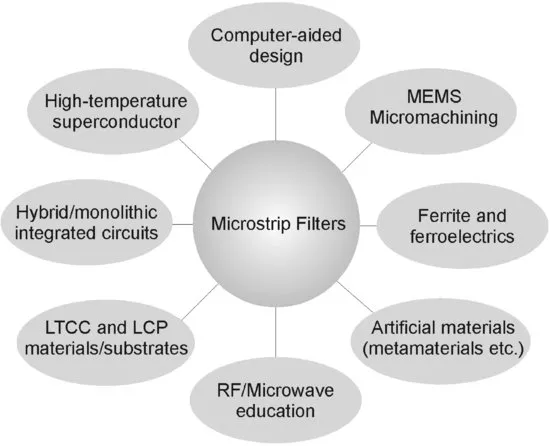![]()
CHAPTER ONE
Introduction
The term microwaves may be used to describe electromagnetic (EM) waves with frequencies ranging from 300 MHz to 300 GHz, which correspond to wavelengths (in free space) from 1 m to 1 mm. The EM waves with frequencies above 30 and up to 300 GHz are also called millimeter waves, because their wavelengths are in the millimeter range (1−10 mm). Above the millimeter wave spectrum is the infrared, which comprises electromagnetic waves with wavelengths between 1 μm (10−6 m) and 1 mm. Beyond the infrared spectrum is the visible optical spectrum, the ultraviolet spectrum, and x rays. Below the microwave frequency spectrum is the radio-frequency (RF) spectrum. The frequency boundary between RF and microwaves is somewhat arbitrary, depending on the particular technologies developed for the exploitation of that specific frequency range. Therefore, by extension, the RF/microwave applications can be referred to as communications, radar, navigation, radio astronomy, sensing, medical instrumentation, and others that explore the usage of frequency spectrums in the range, for example, 300 kHz up to 300 GHz (Fig. 1.1). For convenience, some of these frequency spectrums are further divided into many frequency bands, as indicated in Fig. 1.1.
Filters play important roles in many RF/microwave applications. They are used to separate or combine different frequencies. The electromagnetic spectrum is limited and has to be shared; filters are used to select or confine the RF/microwave signals within assigned spectral limits. Emerging applications, such as wireless communications, continue to challenge RF/microwave filters with ever more stringent requirements — higher performance, more functionalities such as tunable or reconfigurable, smaller size, lighter weight, and lower cost. Depending on the requirements and specifications, RF/microwave filters may be designed as lumped element or distributed element circuits, they may be realized in various transmission-line structures, such as waveguide, coaxial line, coplanar waveguide (CPW), slotline, and microstrip.
The recent advance of novel materials and fabrication technologies, including monolithic microwave integrated circuit (MMIC), microelectromechanic system (MEMS) or micromachining, ferroelectrics, high-temperature superconductor (HTS), low-temperature co-fired ceramics (LTCC), and liquid crystal polymers (LCP), has stimulated the rapid development of new microstrip and other filters. In the meantime, advances in computer-aided design (CAD) tools, such as full-wave electromagnetic (EM) simulators, have revolutionized the filter design. Many novel microstrip filters with advanced filtering characteristics have been demonstrated.
The main objective of this book is to offer a unique and comprehensive treatment of RF/microwave filters, based on the microstrip structure, providing a link to applications of CAD tools, advanced materials, and technologies (see Fig. 1.2). However, it is not the intention of this book to include everything that has been published on microstrip filters; such a work would be out of scale in terms of space and knowledge involved. Moreover, design theories and methods described in the book are not only for microstrip filters, but directly applicable to other types of filters, such as waveguide filters.
Although the physical realization of filters at RF/microwave frequencies may vary, the circuit network topology is common to all. Therefore, the technique content of the book begins with Chapter 2, which describes various network concepts and equations; these are useful for the analysis of filter networks. Chapter 3 then introduces basic concepts and theories for designing general RF/microwave filters (including microstrip filters). The topics cover filter transfer functions (such as Butterworth, Chebyshev, elliptic function, all-pass, and Gaussian response), lowpass prototype filters and elements, frequency and element transformations, immittance (impedance/admittance) inverters, Richards’ transformation, and Kuroda identities for distributed elements. Effects of dissipation and unloaded quality factor of filter elements on the filter performance are also discussed.
Chapter 4 summarizes basic concepts and design equations for microstrip lines, coupled microstrip lines, discontinuities, lumped and distributed components, as well as coplanar waveguide (CPW), and slotlines, which are useful for design of filters. In Chapter 5, conventional microstrip lowpass and bandpass filters, such as stepped-impedance filters, open-stub filters, semilumped element filters, end- and parallel-coupled half-wavelength resonator filters, hairpin-line filters, interdigital and combline filters, pseudocombline filters and stubline filters, are discussed with instructive design examples.
Chapter 6 discusses some typical microstrip highpass and bandstop filters. These include quasilumped element and optimum distributed highpass filters, narrow-band and wide-band bandstop filters, as well as filters for RF chokes. Design equations, tables, and examples are presented for easy reference.
The remaining chapters of the book deal with more advanced topics. Chapter 7, presents a comprehensive treatment of subjects regarding coupled resonator circuits. These are of importance for design of RF/microwave filters, in particular, the narrow-band bandpass filters that play a significant role in many applications. There is a general technique for designing coupled resonator filters, which can be applied to any type of resonator despite its physical structure. For examples, it can be applied for the design of waveguide filters, dielectric resonator filters, ceramic combline filters, microstrip filters, superconducting filters, and micromachined filters. This design method is based on coupling coefficients of intercoupled resonators and the external quality factors of the input and output resonators. Since this design technique is so useful and flexible, it would be desirable to have a deep understanding of not only its approach, but also its theory. For this purpose, the subjects cover (1) the formulation of general coupling matrix, which is of importance for representing a wide range of coupled-resonator filter topologies, and (2) the general theory of couplings for establishing the relationship between the coupling coefficient, and the physical structure of coupled resonators. This leads to a very useful formulation for extracting coupling coefficients from EM simulations or measurements. Formulations for extracting the external quality factors from frequency responses of the externally loaded input/output resonators are derived next. Numerical examples are followed to demonstrate how to use these formulations to extract coupling coefficients and external quality factors of microwave coupling structures for filter designs. In addition, a more advanced topic on general coupling matrix involving source and load is addressed.
Chapter 8 is concerned with computer-aided design (CAD). Generally speaking, any design involves using computers may be called CAD. There have been extraordinary recent advances in CAD of RF/microwave circuits, particularly in full-wave electromagnetic (EM) simulations. They have been implemented both in commercial and specific in-house software and are being applied to microwave filters simulation, modeling, design, and validation. The developments in this area are certainly stimulated by increasing computer power. Another driving force for the developments is the requirement of CAD for low-cost and high-volume production. In general, the investment for tooling, materials, and labor mainly affect the cost of filter production. Labor costs include those for design, fabrication, testing, and tuning. Here the costs for the design and tuning can be reduced greatly by using CAD, which can provide more accurate design with less design iterations, leading to first-pass or tuneless filters. This chapter discusses computer simulation and/or computer optimization. It summarizes some basic concepts and methods regarding filter design by CAD. Typical examples of the applications, including filter synthesis by optimization, are described. Many more CAD examples, particularly those based on full-wave EM simulation, can be found throughout this book.
In Chapter 9, we discuss the designs of some advanced filters, including selective filters with a single pair of transmission zeros, cascaded quadruplet (CQ) filters, trisection and cascaded trisection (CT) filters, cross-coupled filters using transmission-line inserted inverters, linear phase filters for group-delay equalization, extracted-pole filters, canonical filters, and multiband filters. These types of filters, which are different from conventional Chebyshev filters, must meet stringent requirements from RF/microwave systems, particularly from wireless communications systems.
Chapter 10 is intended to describe novel concepts, methodologies, and designs for compact filters and filter miniaturization. The new types of filters discussed include compact open-loop and hairpin resonator filters, slow-wave resonator filters, miniaturized dual-mode filters using degenerate or nondegenerate modes, lumped-element filters, filters using high dielectric constant substrates, and multilayer filters. The last topic covers aperture-coupled resonator filters, filters with defected or slotted-ground structures, substrate integrated waveguide filters, as well as low-temperature cofired ceramics (LTCC) and liquid crystal polymer (LCP) filters.
Chapter 11 introduces high-temperature superconductors (HTS) for RF/microwave filter applications. It covers some important properties of superconductors and substrates for growing HTS films, which are essential for the design of HTS microstrip filters. Typical superconducting filters with super performance for mobile and satellite communications, as well as radio astronomy and radar applications, are described in this chapter.
Chapter 12 focuses on ultra-wideband (UWB) filters, which are a key component for many promising modern applications of UWB technology. In this chapter, typical types of UWB filters are described. This includes UWB filters comprised of short-circuit stubs, UWB filters using coupled single-mode or multimode resonators, quasilumped element UWB filters, UWB filters based on cascaded highpass and lowpass filters, and UWB filters with single- or multiple-notched bands.
The final chapter of the book (Chapter 13) is concerned with electronically tunable and reconfigurable filters. In general, to develop an electronically reconfigurable filter, active switching or tuning elements, such as semiconductor p-i-n and varactor diodes, RF MEMS or other functional material-based components, including ferroelectric varactors and piezoelectric transducers need to be integrated within a passive filtering structure. Typical filters of these types are described in this chapter, which include tunable combline filters, tunable open-loop filters without using any via-hole connections, reconfigurable dual-mode filters, wideband filters with reconfigurable bandwidth, reconfigurable UWB filters, RF MEMS reconfigurable filters, piezoelectric transducer tunable filters, and ferroelectric tunable filters.
![]()
CHAPTER TWO
Network Analysis
Filter networks are essential building elements in many areas of RF/microwave engineering. Such networks are used to select/reject or separate/combine signals at different frequencies in a host of RF/microwave systems and equipments. Although the physical realization of filters at RF/microwave frequencies may vary, the circuit network topology is common to all.
At microwave frequencies, the use of voltmeters and ammeters for the direct measurement of voltages and currents do not exist. For this reason, voltage and current, as a measure of the level of electrical excitation of a network, do not play a primary role at microwave frequencies. On the other hand, it is useful to be able to describe the operation of a microwave network, such as a filter, in terms of voltages, currents, and impedances in order to make optimum use of low-frequency network concepts.
It is the purpose of this chapter to describe various network concepts...


